When the Moon's shadow glides across the U.S. on August 21st, you'll have have a chance to hear the eclipse as it happens.
Solar eclipses are more than remarkable visual astronomical phenomena; they’re pretty interesting from a radio viewpoint too. Should overcast skies prevail over your location on eclipse day, you can still make some interesting observations using an AM radio.
Dramatic changes can take place in radio reception when day changes into night and vice versa. Perhaps you’ve had the experience of driving in your car at night, listening to some program on the AM dial, when the announcer will identify the station as WBBM in Chicago. This might seem odd if you are listening from Albany, New York, more than 700 miles (1,100 km) from the Windy City. Yet, cases like this happen every night.
A total solar eclipse produces a broad, round area of darkness and greatly reduced sunlight that travels across Earth’s surface in a relatively narrow path during the daytime. Its effect on sunlight’s local intensity is remarkably similar to what happens at sunrise and sunset. Distant radio stations along and near to the path of totality might briefly experience enhanced propagation, thus making long-distance reception possible during a solar eclipse unlike any other time.
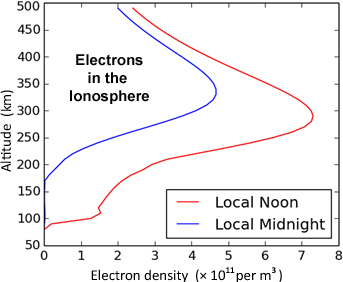
Dieter Bilitza et al / Journal of Geodesy (2011)
We can thank Earth’s ionosphere for natural long-distance radio reception at night. The ionosphere is composed of a set of tenuous, electrically conductive layers that consist of both neutral and charged particles, extending from altitudes of approximately 30 miles (50 km) to more than 250 miles (400 km). The ions present in the ionosphere interact with radio waves in two ways. They can either absorb the waves, thus reducing their intensity and reducing signal strength, or they can refract the waves, changing their direction; conceptually this is akin to a radio-wave "mirror".
The ionosphere’s main refraction layer in the ionosphere, called the F2 layer, is about 180 miles (290 km) above Earth’s surface and is present both day and night. But at a height of some 30 to 60 miles is the D layer, whose impact on radio propagation, especially at lower frequencies, is essentially negative: it absorbs energy from radio signals passing through it to the F2 layer and weakens them.
But as sunset approaches the D layer rapidly loses ionization and essentially vanishes; radio waves are therefore absorbed (depleted) only during the day. So at night, radio waves easily reach the F2 layer, where they are refracted back toward the ground. Likewise, on the way back down, the D layer’s usual obstructions are gone, so the waves reach the ground in a well-preserved state — often many hundreds of miles from the transmitting station.
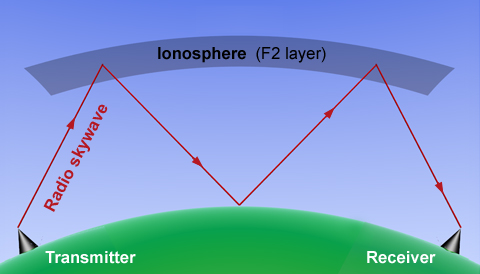
Adapted from Wikipedia Commons
Amplitude modulation (“AM”) is the oldest system of commercial broadcast transmission. The pioneer AM broadcast service started operation on the low frequencies it still uses, 540 to 1600 kilohertz (kHz). In 1993, the bandpass expanded to include frequencies up to 1700 kHz. AM broadcast stations use powers of 250 watts to 50 kilowatts (50,000 watts) — the maximum power permitted in the U.S.
Listening to distant radio signals is a most interesting hobby and is referred to by amateur radio enthusiasts as “DX’ing.” As already pointed out, radio signals in the commercial 540–1700 kHz AM radio band can be heard for hundreds — sometimes even thousands — of miles under the cover of darkness. This is especially true of the so-called “clear channel” (Class A) radio stations. “Clear channels” are frequencies set apart by international agreement for use primarily by high-powered stations designed to cover wide areas with line-of sight “groundwave” service and, at night, “skywave” service, particularly for remote rural areas.
Scenarios for August 21st’s Eclipse
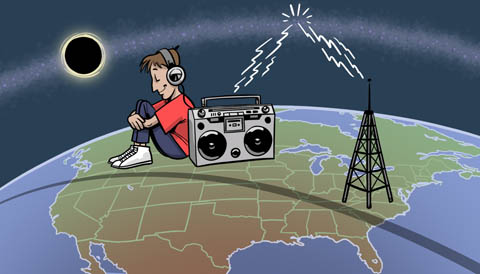
When the Moon’s shadow sweeps across the U.S. on August 21st, some of the best receptions should occur for people within about 400 to 800 miles (600 to 1,300 km) of the narrow totality path of AM stations that are likewise near or within that path. As maximum darkness approaches a station’s transmitter, the D layer should weaken and the F2 layer more able to refract the signal and support long-distance reception.
Listeners within a few hundred miles of such a location might hear a distant station begin to fade in. The broadcast will build in strength until the area of maximum darkness passes over the station, at which time signal strength should be at its peak. Then, as the area of maximum darkness moves away from the station, its signal will begin to fade away.
According to Nathaniel Frissell (Center for Solar-Terrestrial Research, New Jersey Institute of Technology), similar radio studies done at previous solar eclipses suggest that it’s more important for the shadow to pass close to the transmitter, rather than in the midpoint of the propagation path from the transmitter to the listener. “I suspect,” he notes, “that this process is less symmetric than we think it should be. Maybe it is more important to have the D-region hole near the transmitter so that less signal gets absorbed right away.”
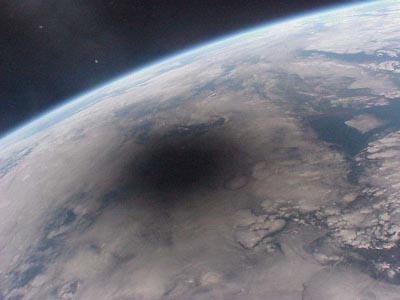
CNES
As an example, on March 7, 1970, a total solar eclipse swept northeastward from northern Florida, up the Atlantic coast, to just off of Cape Cod. An amateur astronomer stationed at Greenville, North Carolina, was able to hear WABC in New York (broadcasting at 770 kHz) for about 20 minutes, centered on the time that 96% of the Sun was eclipsed as seen from the Big Apple.
During the total solar eclipse of August 11, 1999, British radio enthusiasts undertook a nationwide program for monitoring enhanced propagation over a wide range of radio frequencies, including shortwave transmissions. More than 1,700 people participated, and the project found that the eclipse definitely had an effect.
Here’s What to Do
Listed below, are 13 clear channel AM radio stations that lie either within the August’s eclipse path (bold type) or close enough to have at least 95% of the Sun’s disk obscured by the passing Moon. Four of these are Class B stations, which direct their signal diametrically away from another station at night which occupies the same frequency, so that it will not interfere. Case in point: KPNW does this to protect KMOX.
| 50-kw "Clear Channel" AM Radio Stations In/Near Path of August 2017's Total Solar Eclipse | ||||
| Frequency (kHz) | Call Sign | Location | Mid-Eclipse (UT) | Mid-Eclipse (local) |
| 650 | WSM | Nashville, TN | 18:28 | 1:28 p.m. CDT |
| 670 | KBOI (B) | Boise, ID | 17:27 | 11:27 a.m. MDT |
| 750 | WSB | Atlanta, GA | 18:36 | 2:36 p.m. EDT |
| 840 | WHAS | Louisville, KY | 18:27 | 2:27 p.m. EDT |
| 880 | KRVN (B) |
Lexington, NE | 17:57 | 12:57 p.m. CDT |
| 1030 | KTWO (B) |
Casper, WY | 17:43 | 11:43 a.m. MDT |
| 1040 | WHO | Des Moines, IA | 18:08 | 1:08 p.m. CDT |
| 1110 | KFAB | Omaha, NE | 18:04 | 1:04 p.m. CDT |
| 1110 | WBT | Charlotte, NC | 18:41 | 2:41 p.m. EDT |
| 1120 | KPNW (B) | Eugene, OR | 17:17 | 10:17 a.m. PDT |
| 1120 | KMOX | St. Louis, MO | 18:18 | 1:18 p.m. CDT |
| 1190 | KEX | Portland, OR | 17:19 | 10:19 a.m. PDT |
| 1510 | WLAC | Nashville, TN | 18:28 | 1:28 p.m. CDT |
Generally speaking, if you are listening for a particular station that is within 800 miles (1,300 km) away, you might be able to hear it near the time that maximum eclipse is occurring over that station’s transmitter. The map below shows the distribution of the stations in the table.
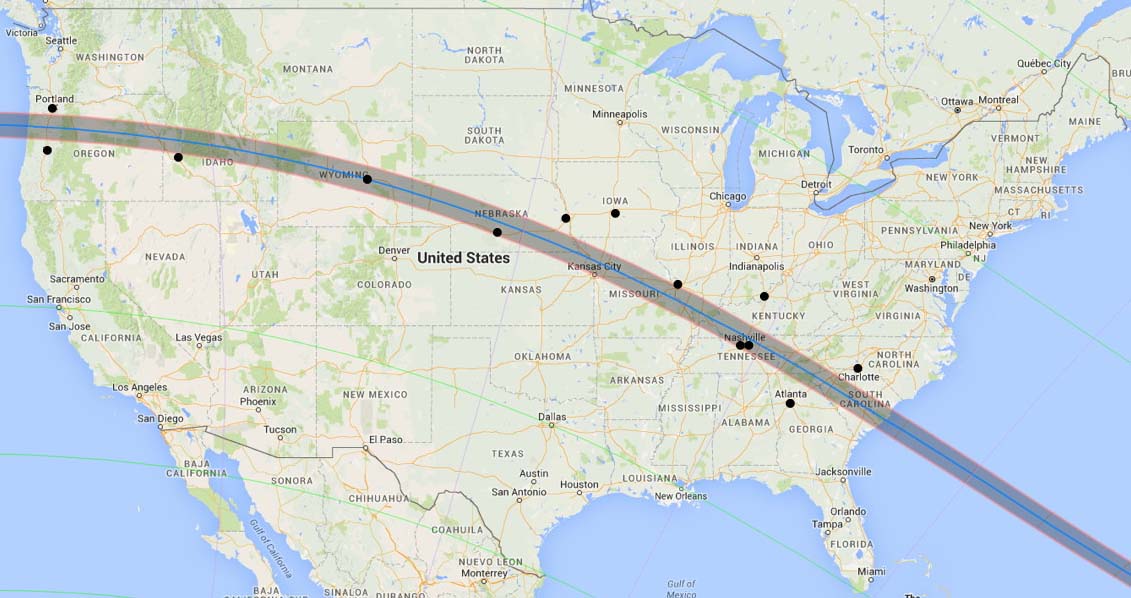
Eclipse map: Xavier Jubier
The equipment needed couldn’t be simpler. Any AM receiver can be pressed into service. If the calibration of your radio isn’t too accurate, try tuning in a particular distant station some night before the eclipse(ideally, August 20th). And sweep through the AM band to determine what reception conditions are like. If your receiver has multiple memory channels with a scanning feature, you’re in luck; such a receiver is ideal for checking a lot of frequencies in a hurry.
I invite you to tune around the AM dial during the eclipse. Send your results — the station you heard and the time that you heard it, along with your location — to me at [email protected]. I’ll compile all the results and report the results of this experiment at a later date.
(And if you are a Ham radio operator, consider participating in an eclipse-related citizen-science project sponsored by HamSCI and American Radio Relay League.)
 6
6
Comments
Russ
July 4, 2017 at 3:44 am
Hi Joe,
This sounds like any easy exercise if clouded out. Also after totality in my location I can listen for stations to the east of me. The two within 800 miles of my Oregon location are Boise, ID and Casper, WY. For ease of use I made a spreadsheet of the table in the above article with stations re-ordered by time of mid-eclipse for that radio station. Then I know when to tune that particular frequency. Should be fun.
Best Regards,
Russ
You must be logged in to post a comment.
Frank-ReedNavigation.com
July 4, 2017 at 3:14 pm
Joe Rao, in the article writes: " or they can refract the waves, changing their direction; conceptually this is akin to a radio-wave 'mirror'."
And indeed, this is how the process of ionospheric 'skip' is almost always described: the waves are REFRACTED downward as if from a radio MIRROR. But wait just a minute, mirrors don't refract --they reflect. We're clearly looking at some sort of reflection, in practical outcome, yet of course the ionosphere is a diffuse medium which should only be capable of refraction. And given that it's really refraction, how does it happen that the radio waves bend downward?? If you've studied basic physics, you know that refraction is caused by a change in wave speed, and that's the case here, too. The speed of the radio waves is higher in the ionospheric layer, and that causes them to bend downward. Counter-intuitively, it's refraction acting like reflection. But it gets worse (or better, if you like fascinating physics-y puzzles). The speed of light INCREASES in the ionospheric layer, and is actually higher than the vacuum speed of light. We have broken the light speed barrier!! But not to worry... it's only the "phase velocity" that climbs above c, not that all-important "group velocity".
Just something to think about....
A little reading: https://en.wikipedia.org/wiki/Kennelly%E2%80%93Heaviside_layer#History
You must be logged in to post a comment.
Mickwilson20
July 7, 2017 at 7:10 pm
Thanks! You saved me from having to pick this own nit myself, and far more diplomatically than I'd have done!
You must be logged in to post a comment.
JoeWx1
August 17, 2017 at 4:58 pm
Hi Frank! I must admit that while DX'ing is a hobby of mine. I'm not a radio expert. I have several amateur radio operators read and re-read my drafts for this article . . . and sometimes they would disagree with each other regarding the proper semantics or wording! Dr. Nathaniel Frissell ([email protected]) was the person had the final look at the article before I sent it off to S&T . . . and he gave it a thumbs up. Maybe it just something that got past everybody who looked at it . . . or maybe there is a reason why refraction fits better than reflection in this case. I will forward your comments to him . . . and the other fact-checkers (all radio amateurs) and see what may have gone awry.
You must be logged in to post a comment.
John Schnupp
July 10, 2017 at 12:19 pm
As a ham radio operator (N3CNL, extra class) the effects of the Sun on radio propagation is a familiar subject. There is a ham radio event planned for the solar eclipse where ham radio operators will contact each other (called a QSO party or contest). The signals from this event will be monitored but the Reverse Beacon Network (a network of receivers that listens to signals and determines station location). The data from the RBN will be analyzed and the effects of the eclipse on the ionosphere and radio propagation will be studied. Additional information here: http://hamsci.org/projects/2017-total-solar-eclipse/2017-eclipse-experiment-description The home page lists additional scientific projects using ham radio.
You must be logged in to post a comment.
JoeWx1
August 24, 2017 at 11:21 am
Hi again, Frank --
I was able to connect with one of my proof readers . . . Dr. Nathaniel Frissel, a long-time amateur radio operator, who replied regarding your comments:
"I don’t think your commenter is technically wrong. We used the term “mirror” instead of “refract” just to simplify the terminology for a general audience. And yes, the refraction occurs because of an changes in phase velocity due to ionospheric gradients, and yes, the phase velocity can be faster than the speed of light. See http://www.navipedia.net/index.php/Ionospheric_ But again what he says is right… phase velocity is allowed to exceed the speed of light in a vacuum because it does not carry information. Group velocity, which carries the information and energy, is not allowed to exceed the speed of light."
73,
Nathaniel
[email protected]
You must be logged in to post a comment.
You must be logged in to post a comment.